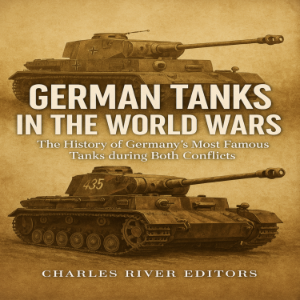

German Tanks in the World Wars: The History of Germany’s Most Famous Tanks during Both Conflicts
Charles River Editors
One of the most important breakthroughs in military technology associated with World War I, and certainly the one that continues to capture the public imagination, was the introduction of a war machine that came to dominate the face of land battles throughout most of the 20th century: the tank. As a concept, it was not revolutionary; in fact, it harkened back to classical antiquity and to the Middle Ages, such as the covered battering rams and testudos which had made frequent appearances on ancient battlefields. In essence, it was designed to solve the age-old problem of protecting infantry from enemy projectiles while remaining mobile. Ironically, Germany, which would subsequently become famous for panzers and blitzkrieg warfare, was late in taking up the idea. During World War I, the Germans continued to rely on other techniques, and they produced less than two dozen models for battlefield use.
The beginning of World War II found the major powers developing tanks to some extent, but lingering ideas from World War I affected the development of tanks during the Interwar period. As a result, aside from the blitzkrieg doctrine developed by the Nazis, tanks were still used in terms of infantry support, and there were few wars during this period to give strategists the chance to develop better uses for the new armored vehicles before World War II started. Commanders soon found that many of the tanks fielded in the campaigns of 1939-1941 lacked the necessary armor, guns, and designs. Inevitably, tactics evolved throughout the war. The Germans were early leaders in tank tactics, as their successes from Poland through the opening phases of Operation Barbarossa demonstrated. The main German tank tactic was the so-called Schwerpunkt (“center of gravity”), in which a concentration of tanks achieved a local superiority, broke through, and drove deep behind enemy lines.
Duration - 3h 8m.
Author - Charles River Editors.
Narrator - Bill Caufield.
Published Date - Wednesday, 08 January 2025.
Copyright - © 2025 Charles River Editors ©.
Location:
United States
Description:
One of the most important breakthroughs in military technology associated with World War I, and certainly the one that continues to capture the public imagination, was the introduction of a war machine that came to dominate the face of land battles throughout most of the 20th century: the tank. As a concept, it was not revolutionary; in fact, it harkened back to classical antiquity and to the Middle Ages, such as the covered battering rams and testudos which had made frequent appearances on ancient battlefields. In essence, it was designed to solve the age-old problem of protecting infantry from enemy projectiles while remaining mobile. Ironically, Germany, which would subsequently become famous for panzers and blitzkrieg warfare, was late in taking up the idea. During World War I, the Germans continued to rely on other techniques, and they produced less than two dozen models for battlefield use. The beginning of World War II found the major powers developing tanks to some extent, but lingering ideas from World War I affected the development of tanks during the Interwar period. As a result, aside from the blitzkrieg doctrine developed by the Nazis, tanks were still used in terms of infantry support, and there were few wars during this period to give strategists the chance to develop better uses for the new armored vehicles before World War II started. Commanders soon found that many of the tanks fielded in the campaigns of 1939-1941 lacked the necessary armor, guns, and designs. Inevitably, tactics evolved throughout the war. The Germans were early leaders in tank tactics, as their successes from Poland through the opening phases of Operation Barbarossa demonstrated. The main German tank tactic was the so-called Schwerpunkt (“center of gravity”), in which a concentration of tanks achieved a local superiority, broke through, and drove deep behind enemy lines. Duration - 3h 8m. Author - Charles River Editors. Narrator - Bill Caufield. Published Date - Wednesday, 08 January 2025. Copyright - © 2025 Charles River Editors ©.
Language:
English
Opening Credits
Duration:00:00:10
Introduction
Duration:00:16:51
The Genesis of the Tank
Duration:00:21:19
The German Response
Duration:00:15:10
The Development of Tank Tactics
Duration:00:05:03
The Development of Tanks after World War I
Duration:00:19:37
Updated Tank Doctrines
Duration:00:11:26
The Panzer I
Duration:00:07:12
The Panzer II
Duration:00:03:54
The Panzer 35(t) and Panzer 38(t)
Duration:00:07:58
German Light Panzers in Action
Duration:00:22:16
The Panzer III
Duration:00:14:22
The Panzer IV
Duration:00:08:50
The Panzer V Panther
Duration:00:05:13
The Panzer VI Tiger
Duration:00:07:19
The Kingtiger
Duration:00:03:45
German Self-Propelled Guns
Duration:00:08:24
The End of the War
Duration:00:09:56
Ending Credits
Duration:00:00:11